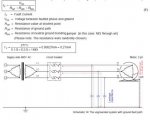Hi,
I have an Ungrounded 4000A,480V 3 phase System, to comply with NEC 250.21(B) we have ground detection lights(GDL) installed on the switchgear. A few of those systems have ground faults indicated by the GDL.
1.The down time on those systems comes at a very high premium, what is the best way to locate those faults without disconnecting the power?
2. Can I use a clamp on ammeter on all 3 phases to locate the short, based on the current reading should be close to zeroA?
I have an Ungrounded 4000A,480V 3 phase System, to comply with NEC 250.21(B) we have ground detection lights(GDL) installed on the switchgear. A few of those systems have ground faults indicated by the GDL.
1.The down time on those systems comes at a very high premium, what is the best way to locate those faults without disconnecting the power?
2. Can I use a clamp on ammeter on all 3 phases to locate the short, based on the current reading should be close to zeroA?
Last edited:


